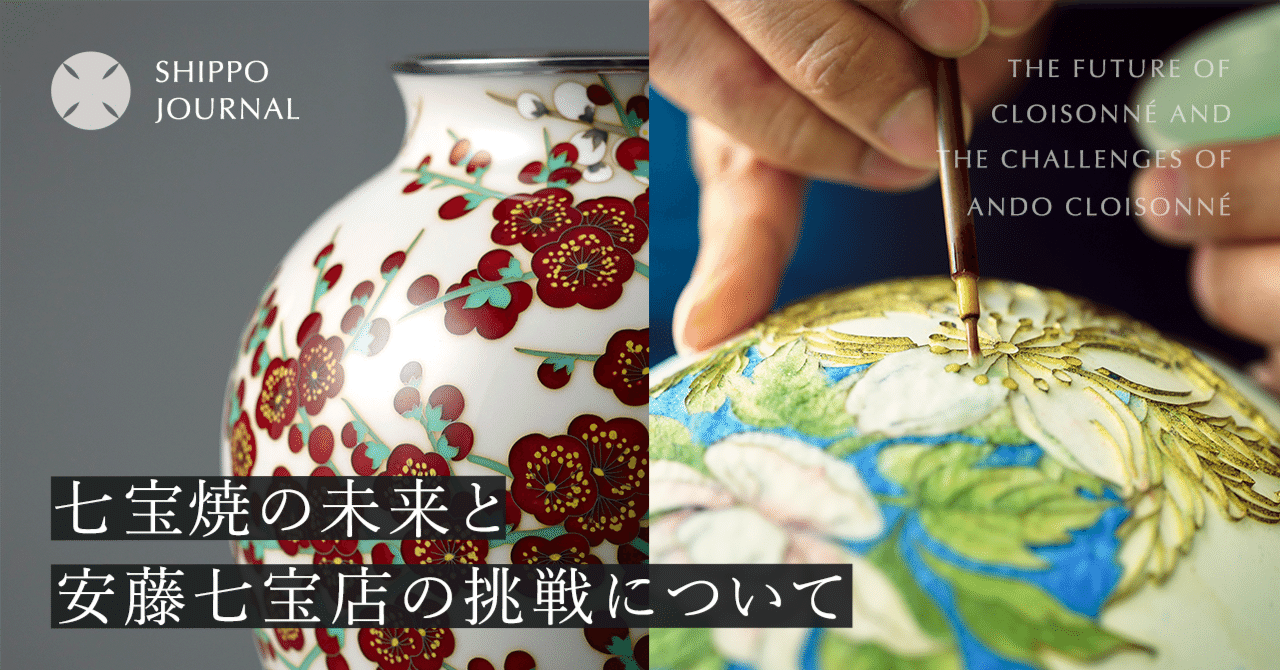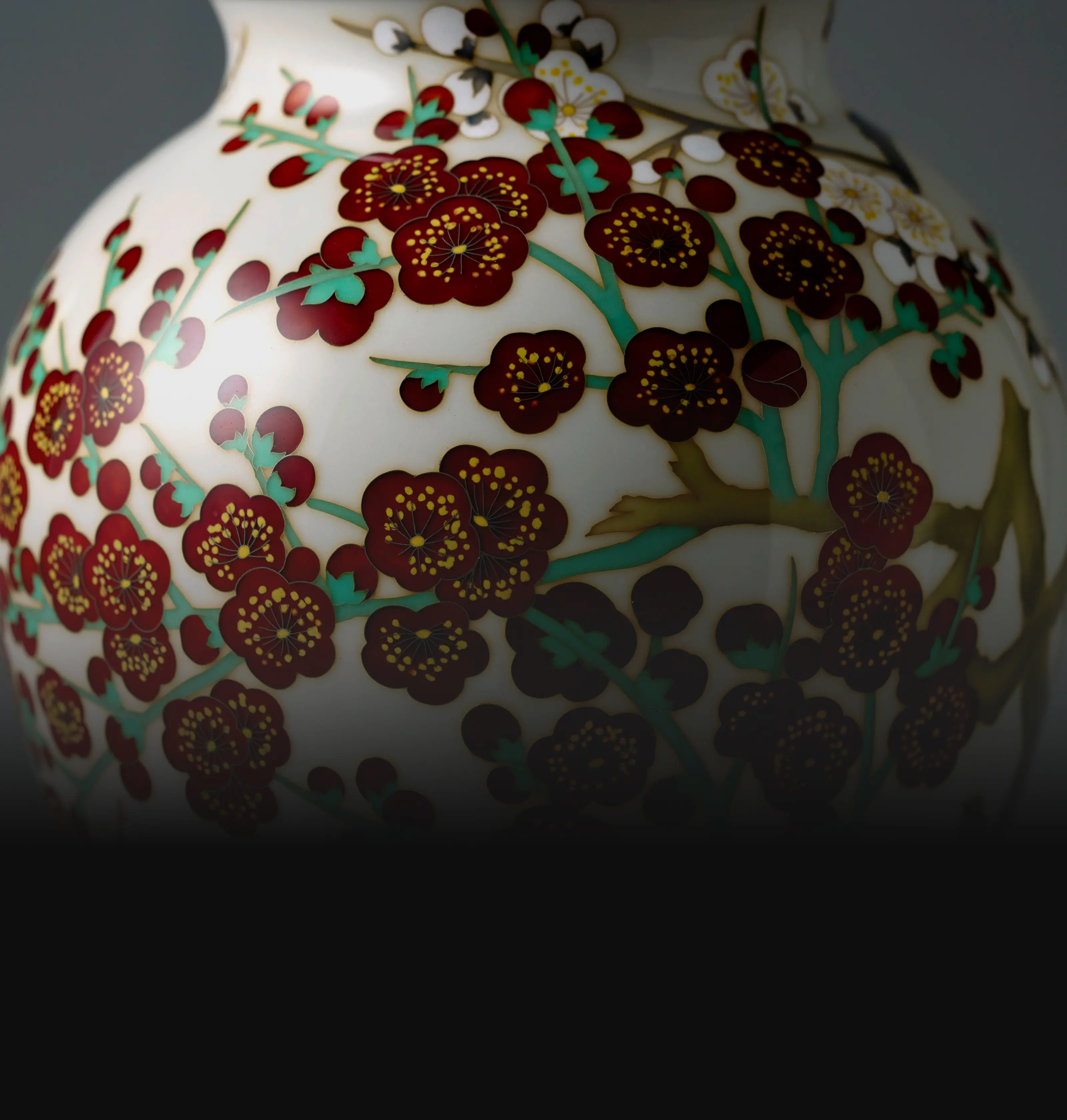About Ando Cloisonne
About us
Cherished Cloisonne, Even in This Age.
The History of Ando Cloisonne
-

Ando Cloisonne opened on September 15, 1880, in Tamaya-cho, Nagoya. Despite the 1880s marked the dawn of modernization, many traditional businesses stuck with traditional commercial practices. Ando Cloisonne's transition from a tobacco pipe merchant to the cloisonne industry was considered a significant adventure by those around them.
-
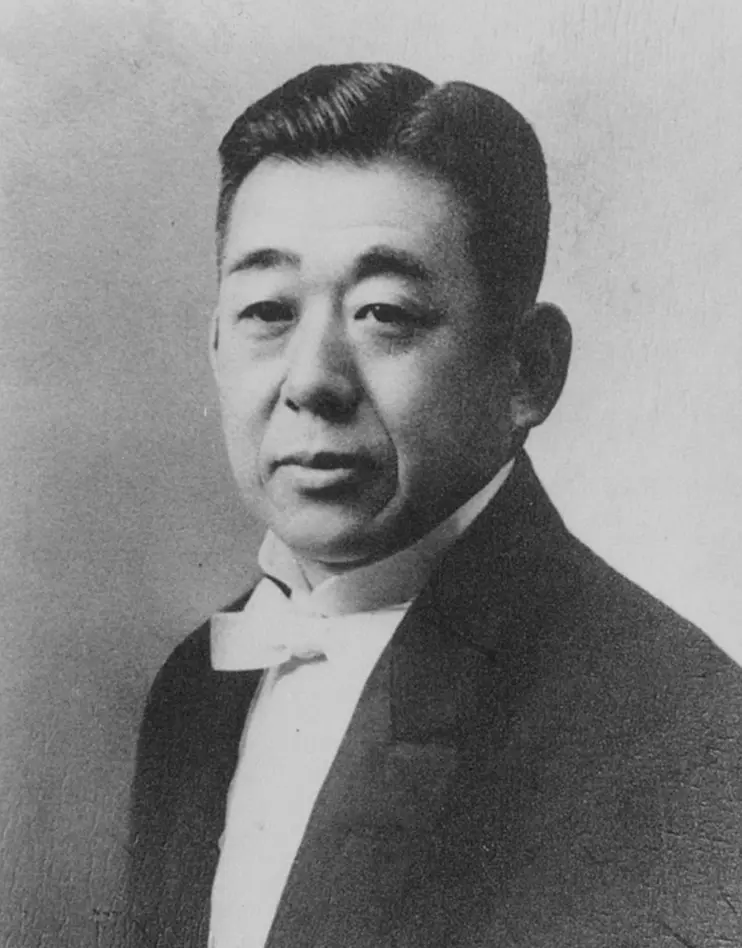
Shigezaemon Ando was just 24 years old when founding of Ando Cloisonne. Traditional Owari Cloisonne, begun by Tsunekichi Kaji, was transitioning to a more luxurious and elegant modern cloisonne. It was a time of frequent cloisonne exhibitions at international expositions, and imports were booming. In 1889, Shigezaemon established a factory, appointing Sataro Kaji, Tsunekichi's grandson, as the factory manager. By 1890, Ando had expanded to Ginza, Tokyo.
His brother-in-law, Jubei Ando (the second generation), who would later become the president, was known for his enthusiastic approach to research. Having studied in England, he acquired knowledge of Western culture and arts and crafts, which inspired him to experiment with various cloisonne techniques. -
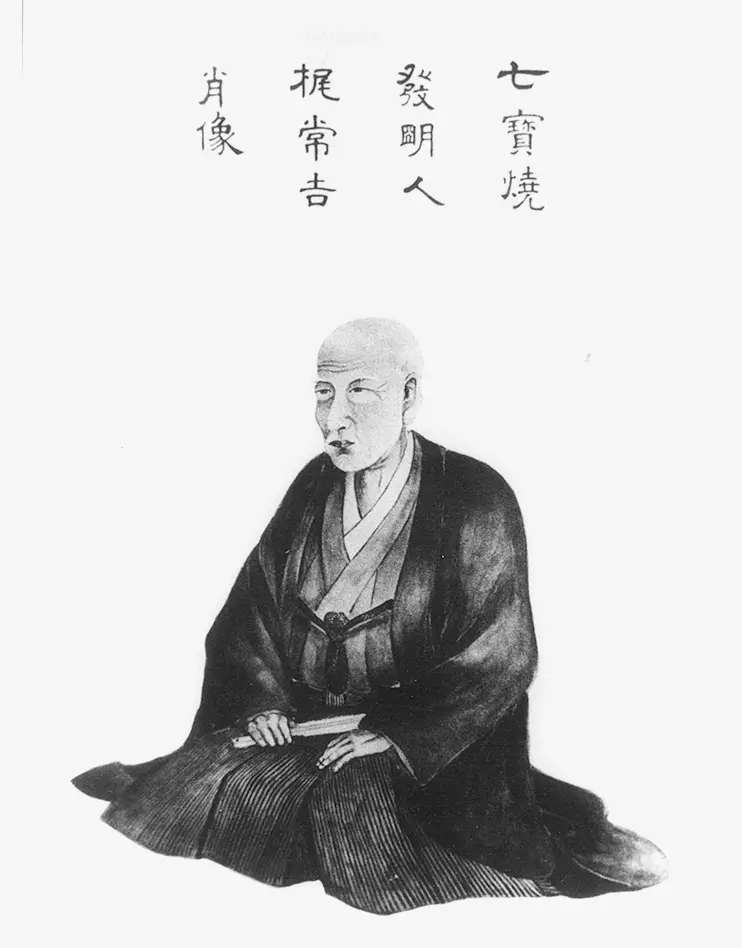
The introduction of cloisonne to Japan reaches back to Tsunekichi Kaji, a fervent devotee to the study of crafts. His fascination with cloisonne began from a mention of it in the Kojiki. His passion ignited when he acquired a Dutch-made cloisonne plate in 1832, marking a turning point for him.
After examining the plate, Tsunekichi daringly smashed it to uncover the secrets of its manufacture. He learned the basic principles of cloisonne making: a copper base and the application of enamel along wire outlines. Through countless trials and errors, he eventually mastered the craft, producing exquisite works.
This technique was passed down directly from Tsunekichi Kaji to Shogoro Hayashi and then to his daughter Ima, with Shogoro Hayashi and Tsunekichi's grandson, Sataro Kaji, becoming the carriers of this lineage. Sataro was later invited to become the factory manager at Ando Cloisonne. -

Although The Great Japan Cloisonne Manufacturing Company had expanded overseas and significantly enhanced the craft's reputation, it began downsizing following the European recession triggered by the 1883 Amsterdam World's Fair and dissolved in 1890.
At this juncture, as Ando Cloisonne celebrated its tenth year, it took over The Great Japan Cloisonne Manufacturing Company, established a new factory, and preserved the flame of the Owari Cloisonne tradition. -

The Tokyo branch of Ando Cloisonne began in a rented house at 3-10 Ginza-cho, Kyobashi-ku, directly in front of the current Matsuya Department Store, a prime location. It was a powerful dream for merchants of that era to open a store among all the other first-class stores in Ginza, but land prices were prohibitively expensive for ordinary people. As Ginza was a popular shopping destination among foreigners, Shigezaemon Ando saw the establishment in Ginza as an opportunity to spread cloisonne abroad. Leaving his young brother-in-law, Jubei, in Nagoya, he ventured to open the Tokyo store in 1890. Advertisements in English targeted at foreigners were initially for made-to-order items, but by 1892, the store had progressed to keeping stock on display regularly.
Around the 1890s, they moved to their self-owned property. By then, Ando Cloisonne had seen significant growth through overseas sales expansion, standing out in the industry. At the same time, in Nagoya, Jubei introduced innovative designs and techniques (such as embossed cloisonne, transparent enamel cloisonne, raised cloisonne, and semi-transparent enamel cloisonne), propelling the store forward. The manufacturing in Nagoya and sales in Tokyo worked in harmony, driving the success of Ando Cloisonne. -

In 1900, Ando Cloisonne was honored by being named a purveyor to the Imperial Household Agency. At the time, this designation was considered the highest honor among merchants and craftspeople. The designation, awarded in Jubei's name, was a recognition of their diligence, solidifying the store's position in the industry and its status in the world of crafts.
Being a purveyor validated the store's credibility, but also a life-and-death commitment to their craft.
The role involved delivering new products alongside restoring damaged items in the collection. Restoration requiring precise color matching and an understanding of firing techniques and enamel application proved an exceptional challenge due to subtle differences in firing techniques and glaze application. Nevertheless, Ando Cloisonne persevered through these trials, experiencing significant growth. -
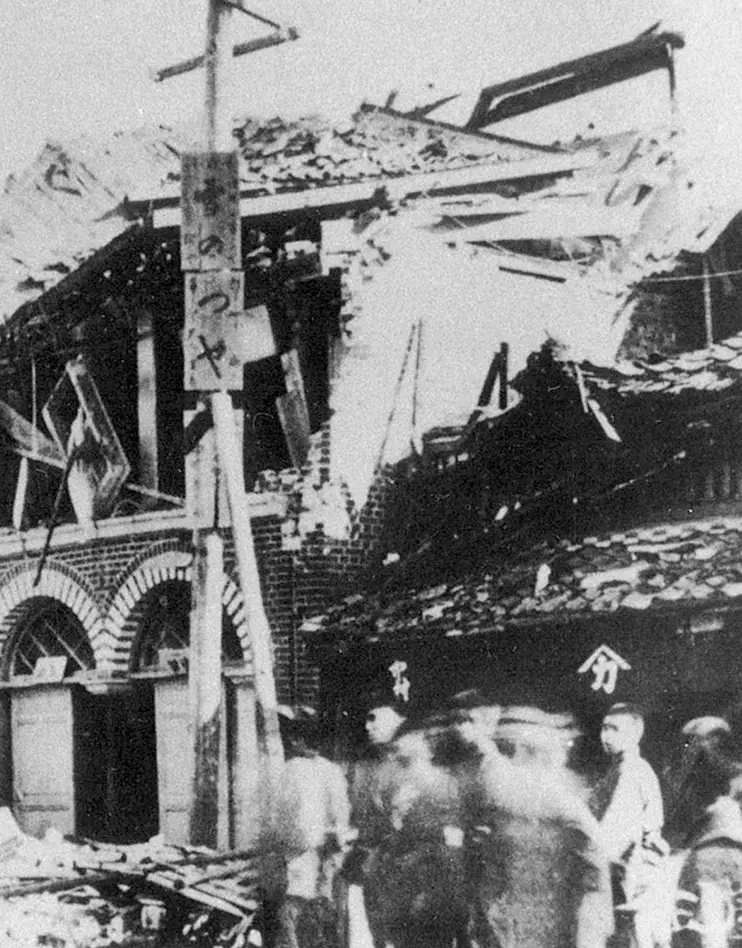
The economic boom brought by victories in the Sino-Japanese and Russo-Japanese Wars was short-lived, and the cloisonne industry suffered during the recession. At the time, the cloisonne business fragmented into manufacturing, sales, enamel production, base making, and metalworking and spread across the country. Some damaged the industry's reputation by engaging in low-quality mass production, while some merchants pressured others to produce low-cost goods, leading to a decline.
Eventually, the recession eliminated these businesses, and the industry stabilized. The cloisonne industry's center shifted to Nagoya, with exports accounting for 80% of the production. Unfortunately, the Owari region suffered a significant blow from the Nobi Earthquake of 1891. Fortunately, Ando Cloisonne in Nagoya suffered minimal damage, and Shigezaemon took the initiative to aid the severely affected cloisonne businesses in western Owari, revitalizing the industry. Some challenges remained with a few companies that opted for low-quality mass production. The Ando brothers led the industry, determined that would not be the future of cloisonne, with innovative designs and focused on producing high-quality items, preserving the reputation of cloisonne craftsmanship. -
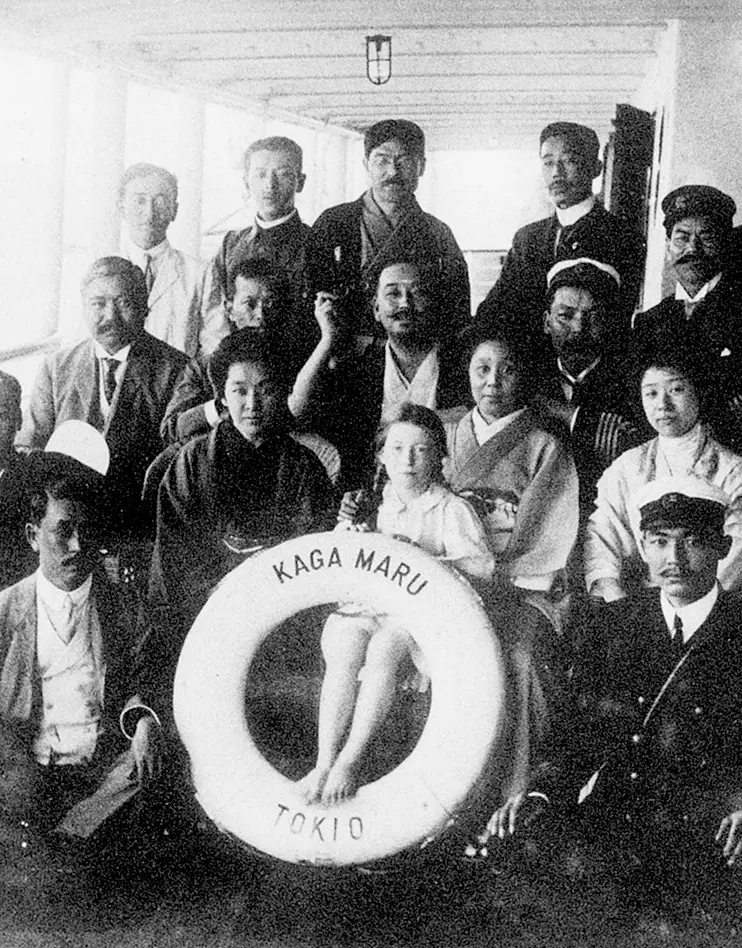
The dual approach of focusing on commerce and artistry led to the expansion of international sales channels. At the time, Nagoya lacked a port, making exports challenging. However, Ando Cloisonne embarked on a journey to sell their products abroad, leveraging international expositions to promote their goods.
The pivotal moment for Ando Cloisonne to gain worldwide recognition was the 1900 Paris Exposition. Seizing this opportunity, Shigezaemon called Jubei to England in 1901 to immerse him in foreign commercial practices firsthand, encouraging the creation of new products based on this experience. Meanwhile, Shigezaemon exhibited at the 1904 St. Louis-Louisiana Purchase Exposition in America and crossed the Pacific again to acquaint himself with Western affairs, later expanding his experiences in Europe.
At the 1910 London Japan-British Exhibition, they won the Grand Prix, and numerous other international expositions, receiving many medals, enhancing their credibility abroad and significantly expanding their market presence. -
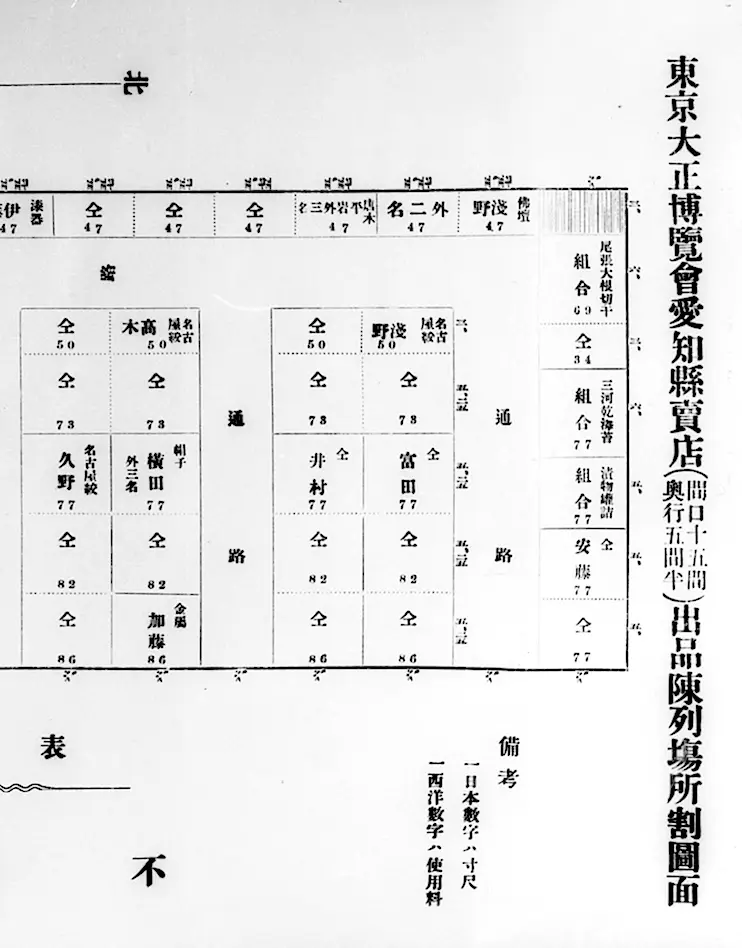
Although the Tamaya-cho area, where the Nagoya store of Ando Cloisonne was a prime location for sellers, it was not suited for manufacturing. Therefore, in 1904, the store moved to Yabacho.
The Taisho era was relatively stable for the cloisonne industry, but it was far from a peaceful time for individual businesses. In the midst of World War I in 1916, the number of cloisonne manufacturers in Nagoya had dwindled to just seven, and the industry was declining due to poor exports and the production of low-quality goods. In 1913, Ando Cloisonne appointed Yoshitaro Hayakawa as a factory manager, focusing on product manufacturing to expand domestic and international sales. At the 1914 Tokyo Taisho Exposition held in Ueno Park, they secured the most prominent front display space with four panels. They had the largest display area and were honored with a gold medal.
Meanwhile, overseas activities flourished, particularly at the Panama-Pacific International Exposition held in San Francisco, USA, where Jubei won the Honorary Grand Prize and returned home to focus on improving new products. Ando's cloisonne became a representative souvenir of Japan for tourists.
A pivotal figure in the expansion of overseas sales was Yoshichika Ando. Born in Fukushima Prefecture in 1885, he met Jubei at the Panama-Pacific International Exposition. Valued for his language skills and personality, he was adopted as a son-in-law in 1920. Yoshichika worked tirelessly to open a branch store in New York, USA, and he also represented the cloisonne industry at the 1926 Sesquicentennial International Exposition in Philadelphia. He primarily worked in Tokyo to expand domestic sales channels and was instrumental in starting hammered cloisonne, showcasing his exceptional talent.
To transition from an individual merchant's approach to more rational management, Ando Cloisonne re-established itself as a partnership company in 1925. The business was restarted with Nagoya as the headquarters and Tokyo as a branch.
This organizational restructuring enabled rational financial management, marking a significant step from an individual business to modern management practices. -

The early Showa period remained tranquil for Ando Cloisonne amidst the global recession and economic turmoil. Due to its established status as a fine arts and crafts producer, it was largely unaffected by the financial panic. In 1927, Ando Cloisonne was to receive the most distinguished honor of welcoming the Emperor's envoy to its main factory.
In 1928, thanks to an invention by Yoshichika, the store introduced a new form of cloisonne, with patterns hammered out of the back of a copper base and enamel applied to the raised areas, with color added to the background. In 1930, in celebration of the Emperor's enthronement, the Emperor and Empress were presented with a Clock with Auspicious Motifs in Gold Wiring and Cloisonne and a Twelve-Pointed Mirror with Decoration in Gold Wiring and Cloisonne from the city of Nagoya. Ando's cloisonne became the acknowledged gift from Nagoya to the Imperial Court.
However, there were issues with the Tokyo branch, which was small and made of wood, presenting a weak point for the company. Therefore, in 1930, the Shippo Building, a three-story reinforced concrete building with one underground floor, was constructed. Despite the severe recession, they built it based on the firm confidence of Jubei in the future growth of Ando Cloisonne. -

Ando Cloisonne continued its active stance in exhibiting overseas, becoming widely known under the name J.ANDO. Remarkable feats include participating in the 1933 World's Fair in Chicago, USA, and crafting gifts for the Imperial Court from Nagoya city to celebrate the birth of Crown Prince Akihito on December 23 of the same year.
However, after receiving the prestigious award at the Nagoya Pan-Pacific Peace Exposition in 1937, the industry suffered a significant blow due to restrictions on the use of copper and the July 7th Decrees, which limited the manufacturing and sale of luxury goods, forcing a period of stagnation and decline. The cloisonne industry saw numerous closures, leaving Ando to uphold the craft's legacy.
Even under these circumstances, they took measures to preserve these traditional crafts and pass on their techniques. In 1943, the Cloisonne Technique Preservation Corporation was established in Nagoya, with Ando holding over a quarter of its shares, representing a significant burden.
At the time, only industries contributing to military needs were considered essential, so the heavy commodity tax also became a strain. Reflecting on the tax burden that reached 120%, it seems miraculous that the spark of their technique survived. Adding to their woes, air raids destroyed major cities; the Nagoya main store burnt down, losing all inventory, and the Tokyo Shippo Building was also destroyed by fire three times. At war's end, the company was left crippled, barely breathing, enduring in silence, and hopeful for the dawn of a new era. -
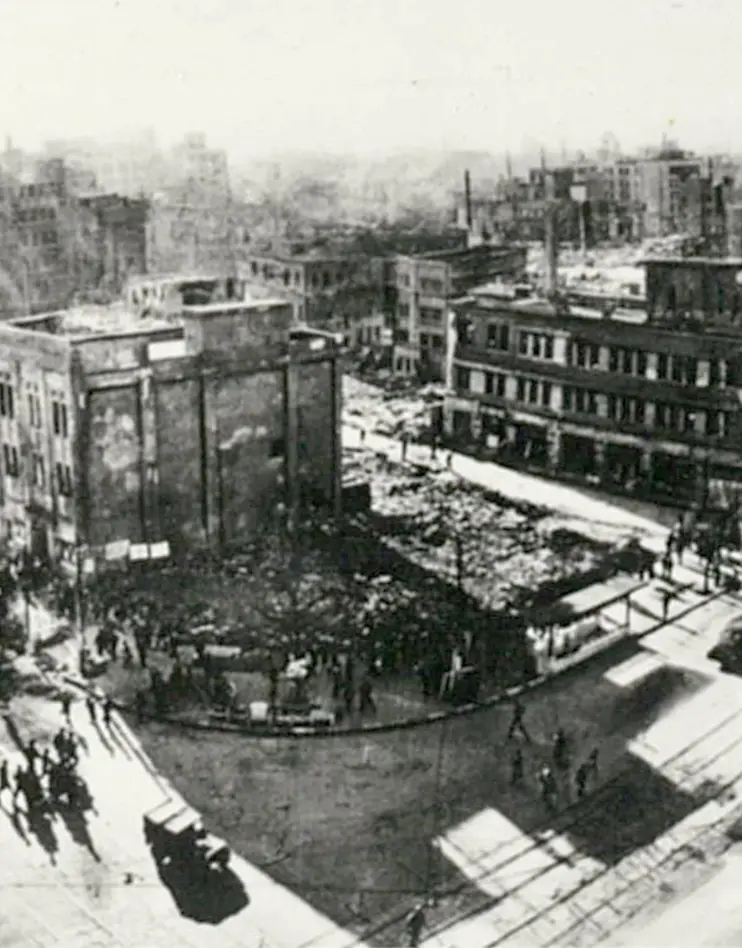
With the end of the Pacific War in 1945, Japan was defeated and welcomed peace amidst its significant scars. As the era for cloisonne to shine once again arrived, Jubei and his son-in-law, Takeshiro Ando, who had married into the Ando family, swiftly rose to the challenge of reconstruction. Their efforts were remarkable, beginning the reconstruction of the main factory on December 8th, and by 1947, they celebrated the reopening. However, free trade was not yet permitted, leading to less than favorable business conditions.
During this period, Ando Cloisonne contemplated the future of cloisonne ware and decided to transition into a corporation with a public character. This move was aimed at ensuring the survival and healthy development of the cloisonne industry by not keeping the technology in the hands of individuals alone. Despite criticism for the company's need for a mass production system, there was a firm belief in the need for products that everyone could afford. -
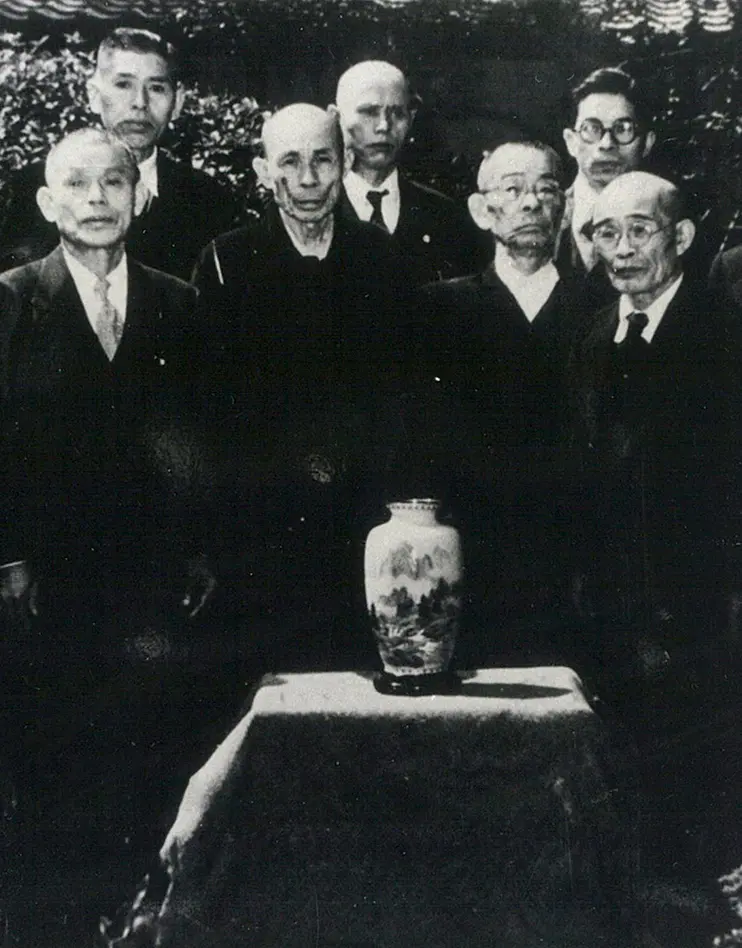
It took six long years for both business management and production to get on track fully. Although there was a cloisonne boom among stationed military personnel, rampant black market dealings led many in the industry to lose sight of the right path, resulting in a decline in quality resulting in an unfortunate era. Amidst this, Ando Cloisonne, steadfast in maintaining fair prices, fell into poor performance.
To turn things around, in 1951, Ryokichi Kubodera was appointed as the managing director president, with Takeshiro becoming the manager. This decision led to steady growth, allowing the company to emerge successfully from the period of turmoil.
Around the same time, the government, aiming to build a new cultural nation, showed an active stance in fostering and preserving traditional craft techniques. In May 1951, the Cultural Properties Protection Committee established and announced standards for grants to intangible cultural properties. In March 1952, cloisonne techniques were designated as one of the intangible cultural assets. This was a timely event for the cloisonne industry, which was finding it difficult to secure successors. It was the first time that the technique was preserved in a technical book. -

In November 1954, Takeshiro Ando assumed the role of the third president of the company. He was deemed perfectly suited to develop new demands expand the business and preserve and enhance world-class technology, passing it on forever. Riding the wave of prosperity, on March 30, 1957, five employees were selected as technicians of Intangible Cultural Properties for Which Measures for Record Creation Should Be Taken. On the commercial front, the development of trophies, cups, and products incorporating new designs into old techniques made cloisonne more accessible to the public. Efforts to expand sales channels were actively pursued, including the opening of direct sales stores and the Cloisonne History Exhibition.
During this era, innovations such as Colored Enamel Cloisonne, which leveraged the unique characteristics of enamel and the appeal of copper bases; Cast Iron Cloisonne with a national flavor; Enamel Cloisonne offering a pictorial taste; and Relief Cloisonne, blending the beauty of sculpture with the luster of enamel, were developed.
At the same time, the preservation of tradition was not forgotten. In the spring of 1959, to commemorate the marriage of the Crown Prince, a pair of Bugaku Seigaiha Pattern Large Vases were crafted. This project was significant as a grand effort to fully convey traditional techniques. In 1961, the Cloisonne Technique Preservation Record was published, among other initiatives to make cloisonne ware more accessible. At that time, although there was resistance to disclosing techniques, Ando Cloisonne chose to do so, bolstering confidence in creating superior products. In 1968, an office was established in Osaka, and by 1965, the construction of the second Nagoya factory was completed, yielding significant results.
In November 1968, the North Hall of the new Imperial Palace was adorned with decorations made by Ando Cloisonne, including a replica of the Twelve-Pointed Mirror with Decoration in Gold Plating and Cloisonne from the Shosoin Imperial Repository, which took about 21 months to complete. This unique mirror, unprecedented in its kind, demanded the convergence of modern cloisonne techniques to be unified on a single plate, showcasing the craftsmen's dedication to pushing the limits, and impressing the public upon its unveiling. -
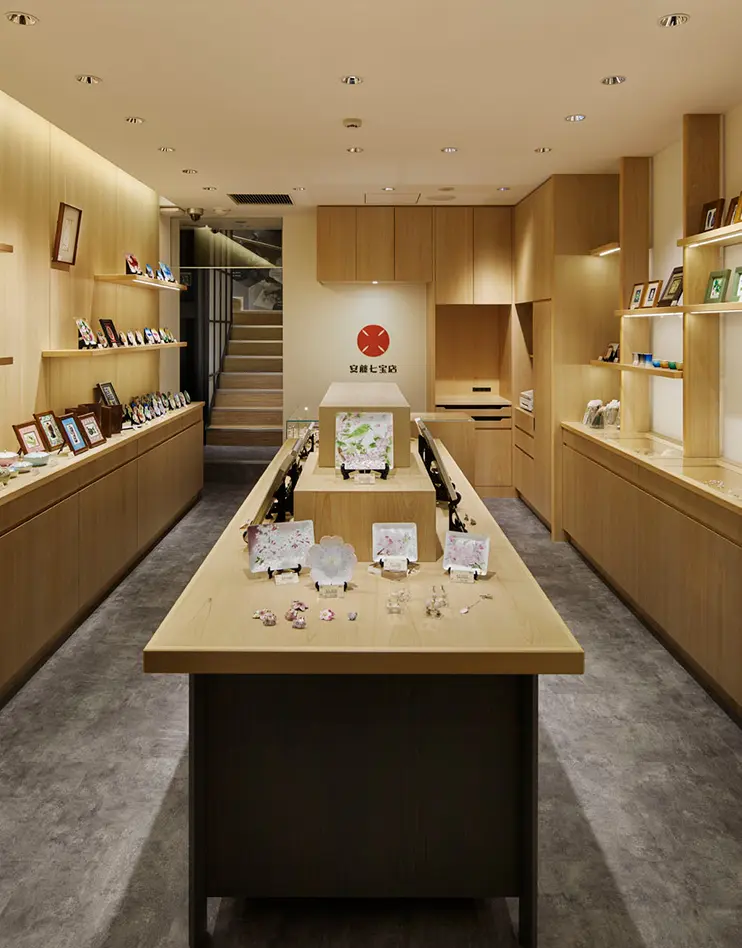
In 1983, Shigeyoshi Ando became the fourth president. In 1989, the Ginza Cloisonne Building was completed, housing the Ando Cloisonne Tokyo branch and Ginza store, marking an era dedicated to the continuation of Japanese crafts beyond just cloisonne.
In 1993, for the 61st Ise Grand Shrine Reconstruction, a Cloisonne Suedama (cloisonne ornaments) was created. In 1998, the 'Seiryu-sha' festival float belonging to the Handa Ishibashi group underwent a restoration project, which included the refurbishment of four cloisonne pillars. Then, in 2005, the Kyoto State Guest House commissioned the creation of handshake and collision prevention signs, among other unique projects such as restorations commissioned by both the national and local governments. These tasks were carried out by leveraging the advanced technical skills that have been cultivated and passed down through generations.
Moreover, Shigeyoshi Ando served as the representative director of the Traditional Craft Industry Promotion Association from 2015 to 2019, contributing to the transmission of Japanese crafts. In 1995, Owari Cloisonne received designation as a national traditional craft. -
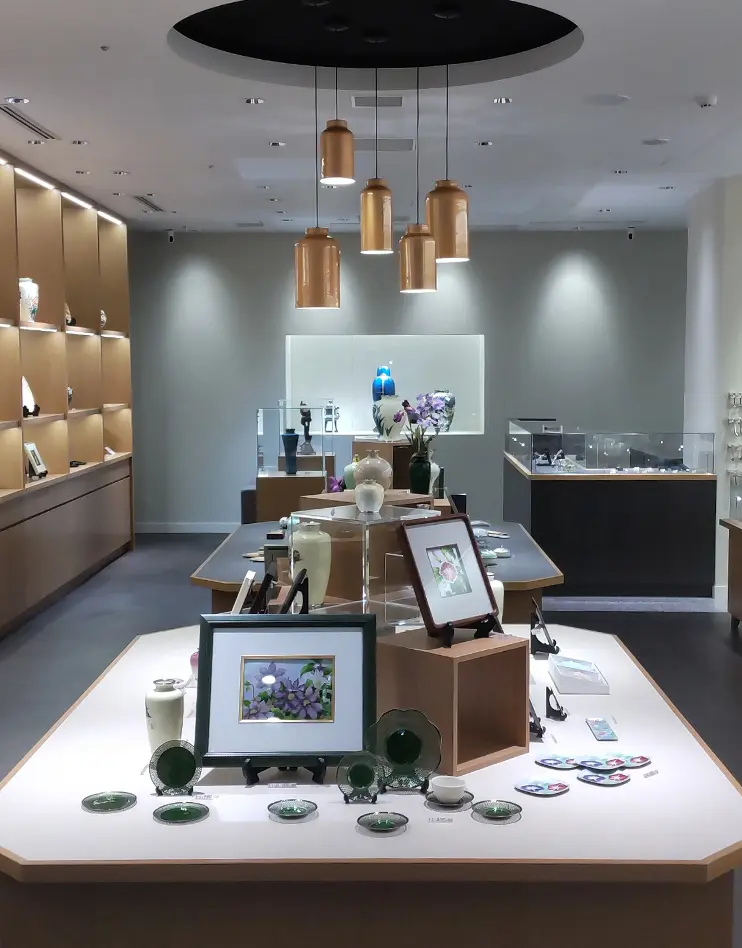
Entering the Reiwa era, the Japanese craft industry, including cloisonne, faced difficulties in business continuation due to industry contraction. Shigeyuki Ando, who became the fifth president in 2015, restructured company assets to create financial stability.
However, challenges in technological succession also emerged, facing a crisis with the potential loss of exquisite techniques developed over time. In 2019, during the relocation of the aging headquarters factory from Gokiso to Minami Ward Yajie Town, the Niigata Tsubame factory was also consolidated into the Yajie factory, aiming for in-house production and actively hiring personnel for the next generation's technological succession, striving to keep the tradition of Owari Cloisonne alive. Additionally, active product development was pursued to meet contemporary demands, considering that without demand, preserving cloisonne would become untenable.
In 2022, the Ginza store was relocated to the Ginza Center Building. In 2023, the Nagoya headquarters, which had operated for approximately 120 years, was sold, and the Nagoya main store was relocated to the first floor of the Nagoya Heiwa Building, where it stands today.
